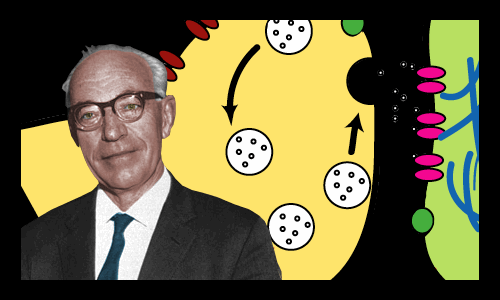In a little over one year we will be voting in the next general election, and of equal importance, also in the referendum on Drug Reform that will include the legal status of Cannabis in this country. While thinking about this recently, my thoughts went back to my early days at Medical School and to one of our lecturers involved in research of the synapse. This is the microscopic anatomical gap between two nerves and between the end of a nerve and either a gland or a muscle, and one of the unanswered medical mysteries at that time was how does a nervous impulse jump the gap?
In 1946, John Eccles was Professor of Physiology in Dunedin, an Australian, a big man with large hands and a loud voice. Someone meeting him for the first time might take him for a farmer from the Outback rather than a brilliant academic on his way to solving that mystery – he was a neuroscientist before it was fashionable.

Sir John Eccles
From Dunedin, Eccles returned to Australia and thence to Oxford to continue his research and where it was proved that chemicals liberated from nerve endings crossed the gap to act on specific receptors on the next relay and so continue the nerve impulse. This was arguably as great a discovery as that of penicillin. It opened the way for the modification of the naturally produced chemicals by introduced chemicals such as anaesthetics, and mind -altering drugs both legal and lethal. The specialty of psychiatry would now have therapeutic drugs with predictable effects.
In 1963 Eccles shared the Nobel Prize for medicine with his Oxford colleagues. He was knighted, and received many Honorary Doctorates of Law, Science as well as Medicine from many of the world's leading academic institutions. We ignorant medical students could have had no concept that he was on his way to greatness, and of the significance of his work. To us he was just "Synaptic Jack".
But what has that to do with the referendum which presently is being debated at length in the Health Select Committee? While this involves wide ranging discussion I believe that of main interest to the public will be the question of cannabis for personal use, for both recreational and medical purposes. And it is the synapses, especially those in the brain that do not go well with cannabis. The referendum questions will be awaited with great interest and I wonder will it even be possible to word one clearly enough for us to give a simple "yes" or "no" answer.
If cannabis is legalised it would then be able to be grown and possessed by adults for their own use. The age of 20 has been mentioned already. But of great concern would be the ease with which minors in the household could access an older sibling's joint with potentially disastrous results. It is in the brain where synapses are found in the greatest concentrations, present in astronomical numbers. Of special interest is the frontal cortex, the area just behind the eyebrows, and it is here that incoming sensory information is processed and conscious motor activity is initiated. Working memory lives here with brief storage for recent events. This highly differentiated region does not reach full adult state until the age of about 25, with constant modification of the synapses during earlier developing years when they are particularly susceptible to the harmful effects of cannabis. It is here in the synapse, the meeting place between electricity and chemistry, that the mood-altering drugs have their often sinister effects by interfering in the orderly manufacture, release, reabsorption or breakdown of neuro-transmitters.

Cannabis sativa
The plant of immediate concern is the Cannabis sativa with over 60 cannabinoids in the stem, leaves and flowers. Marijuana is prepared from the dried leaves and flowering tops, where the greatest concentration of THC (Tetrahydrocannabinol) is found. This is the most psychoactive of the cannabinoids and its concentration can be raised unpredictably by selective breeding. During smoking, chemicals are absorbed directly into the large blood vessels of the nose and lung, metabolised in the lung and liver, and the THC is delivered to the brain. Unlike alcohol, THC is fat soluble and remains in body lipids and especially the nervous system long after it has been removed from the bloodstream. THC is similar to sunburn – sunburn does not go away when the sun sets.
I have spoken with people, including a 24-year-old, who have had professional association with youths suffering from drug-induced psychosis, invariably related back to initial contact with marijuana. They are horrified at the prospect of any youth being exposed to second-hand THC from homemade marijuana legally produced in their home.
It is ironical that while we are maintaining strenuous efforts to reduce smoking tobacco products, we are considering freeing up restrictions on smoking cannabis without any clear idea of the long-term adverse effects on health. If cannabis is proven to be carcinogenic, who will the complainants sue? And if tobacco now was illegal, and knowing how harmful it is, I wonder how we would vote in a referendum to legalise it.
When we do vote let's keep in mind the young, and especially their synapses, and think carefully before agreeing to take down the fence.